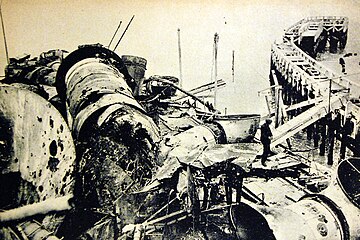HMS Vindictive (1897)
Coordinates: 51°14′22″N 2°55′32″E / 51.2393734°N 2.9256020°E
This article needs additional citations for verification. (April 2008) |
 HMS Vindictive in 1900
| |
| History | |
|---|---|
| Name | HMS Vindictive |
| Builder | Chatham Dockyard |
| Launched | 9 December 1897[1] |
| Commissioned | 1899 |
| Fate | Expended as blockship, 1918 |
| Status | Scrapped in 1920. Bow preserved as a memorial |
| General characteristics | |
| Class and type | Arrogant-class cruiser |
| Displacement | 5,750 tons |
| Length | 342 ft (104 m) |
| Beam | 57 ft 6 in (17.53 m) |
| Propulsion | Triple expansion engines, 2 screws, 10,000 hp (7,457 kW) |
| Speed | 19 knots (35 km/h; 22 mph) |
| Complement | 480 |
| Armament |
|
| Armour | Deck : 3 in (76 mm) |
HMS Vindictive was a British Arrogant-class cruiser built at Chatham Dockyard. She was launched on 9 December 1897 and completed in 1899. The vessel participated in the Zeebrugge Raid.
Service history[]
Vindictive served with the Mediterranean Squadron from 1900,[2] Captain Herbert Augustus Warren in command. Attached to the cruised division, she visited Larnaka in June 1902,[3] and took part in combined manoeuvres between the Mediterranean and Channel fleets in the Aegean Sea and off Argostoli in September and October that year.[4]
She was refitted in 1909–10 for service in the 3rd Division of the Home Fleet. In March 1912 she became a tender to the training establishment HMS Vernon. Obsolescent by the outbreak of First World War, in August 1914 she was assigned to the 9th Cruiser Squadron and captured the German merchantmen Schlesien and Slawentzitz on 7 August and 8 September respectively. In 1915 she was stationed on the southeast coast of South America. From 1916 to late 1917 she served in the White Sea.
Early in 1918 she was fitted out for the Zeebrugge Raid. Most of her guns were replaced[citation needed] by howitzers, flame-throwers and mortars. On 23 April 1918 she was in fierce action at Zeebrugge when she went alongside the mole, and her upperworks were badly damaged by gunfire, her Captain, Alfred Carpenter was awarded a Victoria Cross for his actions during the raid. This event was famously painted by Charles de Lacy, the painting hangs in the Britannia Royal Naval College.[5] In addition to her usual complement, she embarked Royal Marine gunners to man the supplementary armament, and a larger raiding party. This comprised two of the three infantry companies of the 4th Battalion, Royal Marine Light Infantry, (their third company was embarked on the Iris), along with two "companies" of seamen raiders commanded by Lieutenant Commander Bryan Fullerton Adams and Lieutenant Arthur Chamberlain ("A" & "B" seamen Companies) respectively.[6]
She was sunk as a blockship at Ostend during the Second Ostend Raid on 10 May 1918. HM Motor Launch 254 picked up 38 survivors of Vindictive's 55 crewmen. The ship's Commander Alfred Godsal perished on board. The wreck was raised on 16 August 1920 and subsequently broken up. The bow section has been preserved in Ostend harbour serving as a memorial. One of Vindictive's 7.5-inch howitzers was acquired and preserved by the Imperial War Museum.[7]
The Zeebrugge and Ostend Raids, with their associated crop of VCs, had given the ship late celebrity and her name was perpetuated by renaming the aircraft carrier HMS Cavendish, which was under construction, as Vindictive.

HMS Vindictive sunk after the Second Ostend Raid.

Vindictive's damaged superstructure

HMS Vindictive memorial in Ostend at its original location.

HMS Vindictive memorial in Ostend at its new location.

Charles John De Lacy - HMS 'Vindictive' at Zeebrugge, 23 April 1918
References[]
- ^ The Times (London), Friday, 10 December 1897, p.7
- ^ "Naval & Military intelligence". The Times (36433). London. 19 April 1901. p. 10.
- ^ "Naval & Military intelligence". The Times (36801). London. 23 June 1902. p. 6.
- ^ "Naval & Military intelligence". The Times (36896). London. 11 October 1902. p. 11.
- ^ "Art UK entry with reproduction of the ''Vindictive'' at Zeebrugge painting. Retrieved 9th june 2013". Art UK. Retrieved 23 April 2014.
- ^ Keyes, Roger, ed. (1918), Reports on Zeebrugge and Ostend operations., Admiralty, pp. 11–13, 61–66, 74–80, ADM 137/3894
- ^ "BL 7.5in Howitzer Mk I". iwm.org.uk. Imperial War Museum. Retrieved 30 January 2012.
Publications[]
- Colledge, J. J.; Warlow, Ben (2006) [1969]. Ships of the Royal Navy: The Complete Record of all Fighting Ships of the Royal Navy (Rev. ed.). London: Chatham Publishing. ISBN 978-1-86176-281-8.
External links[]
| Wikimedia Commons has media related to HMS Vindictive (ship, 1897). |
- Arrogant-class cruisers
- Ships built in Chatham
- 1897 ships
- World War I cruisers of the United Kingdom
- World War I shipwrecks in the North Sea
- Maritime incidents in 1918





